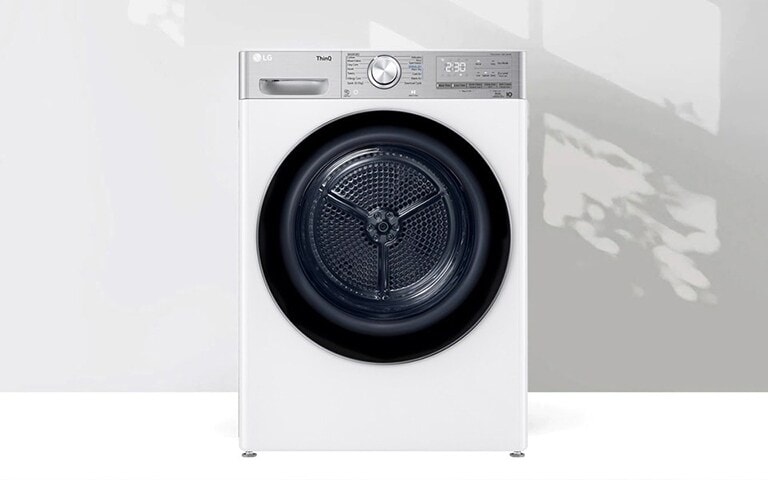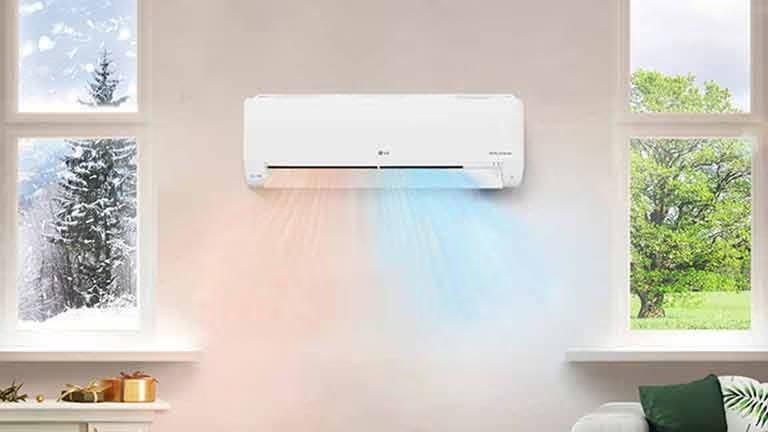We use cookies, including cookies from third parties, to enhance your user experience and the effectiveness of our marketing activities. These cookies are performance, analytics and advertising cookies, please see our Privacy and Cookie policy for further information. If you agree to all of our cookies select “Accept all” or select “Cookie Settings” to see which cookies we use and choose which ones you would like to accept.
Buying Guides
Dryer Buying Guide
Dryer Buying Guide
In search of a new clothes dryer? With so many options out there, it can be difficult to know which one is going to be right for you. We’ve put together a handy guide, to help you understand the differences between heat pump dryers and other types like condenser and vented dryers; we’ll also cover capacity, and look at the features you’ll find on selected LG models. Consider this the ultimate guide to buying a brand new dryer for your home.
What is a Heat Pump Dryer and How Do They Work?
What is a Heat Pump Dryer and How Do They Work?
You’ll notice that our range of dryers are listed as ‘heat pump dryers,’ and you may be wondering what this means.
Heat pump dryers are a type of condenser dryer, and they’re more modern than the traditional vented types. They use heat pump technology to warm the air and absorb moisture from your clothes; this creates condensation, which is then collected in a water tank or reservoir. The dry air that’s left is then recycled and pumped back through the drum to dry out your laundry.
The Benefits of a Heat Pump Dryer
The Benefits of a Heat Pump Dryer
Here are some of the pros of heat pump dryers:
● Because they reheat and recycle hot air created inside the drum, heat pump dryers are known for their energy efficiency.
● They’re also cheaper to run and don’t need to be plumbed in, because all the moisture is stored in a tank that can be manually emptied. This means that you have more flexibility in terms of where you put them; if you live in an apartment or don’t have a separate utility room in your home, you can still easily install a heat pump dryer.
● Since they dry loads at lower temperatures, heat pump dryers are also gentler on clothes.
Heat Pump Dryers vs. Condenser and Vented Dryers
As we mentioned, heat pump dryers are actually a type of condenser dryer, but there’s one key thing that distinguishes the two types.
The main difference between heat pump and condenser dryers is that condenser dryers don’t recycle hot air in the drum. While they can dry clothes quickly, they’re not as energy efficient and can cost more to run. In a condenser dryer, moisture is extracted from wet laundry and drained away; the air is heated over a coil into the drum, which then dries your laundry.
Heat Pump and Condenser Dryers vs. Vented
Both heat pump and condenser dryers differ quite significantly to vented clothes dryers. Vented dryers may need to be fitted with a pipe that removes the damp air, either through a window opening or a permanent fixture in the wall.
These types are cheaper to buy, but they’re more inflexible and more expensive to run, so if you don’t have the space to dry your clothes on a rack or a washing line, you may not want to fork out for a vented dryer in the long run. They’re not suitable for homes with limited ventilation either, so if you live in a city centre unit or don’t have the outside space to accommodate external piping, you’d be best choosing a heat pump or condenser dryer.
What Size Dryer Do You Need?
Clothes dryers come in a range of sizes, and the size you choose will be dependent upon your household size and how frequently you’ll be drying your clothes in the machine (rather than on a rack or clothes line).
You’ll also need to consider two aspects of sizing: the physical dimensions, and the capacity of the dryer.
Take note of the dimensions of any dryer you’re looking at in the product specifications, and check this against the space that’s available in your home. You’ll be given the width, depth and height of the dryer, as well as the weight; remember to factor in some additional room at the back and sides for ventilation.
The capacity of a dryer is measured in kg, and refers to the dry weight of a load, not the wet weight. At LG, we have medium and large dryers, with 8, 9 or 10kg capacities. Our 8kg clothes dryers are ideal for most average-sized families; our 9kg and 10kg models are best for larger households, or for those who have more weekly laundry to dry. You should also consider buying a large-capacity dryer if you’re likely to use it for drying bulkier items, such as duvets.
Features to Look Out For on LG Clothes Dryers
Features to Look Out For on LG Clothes Dryers
Our dryers use a range of innovative technologies that are designed to make your life that little bit easier. Here’s an overview of the special features you’ll find in selected LG models.
Inverter Control
Inverter control technology reduces motor friction, so these machines operate with less noise than other types. Inverter motors are digitally controlled, which adjusts the power and spinning speed to make them work more efficiently. Additionally, these dryers are durable, so you don’t need to worry about servicing or repair costs quite as much.
Auto Cleaning Condenser
LG’s Auto Cleaning Condenser technology automatically cleans the condenser 1-3 times per cycle, so you don’t have to remove the lint from the condenser manually. It’s important to keep the condenser in your machine clean to ensure it continues to function properly*; our Auto Cleaning Condenser feature does that for you, saving you time and effort!
*The cleanliness of the condenser may differ depending on the operating environment.
Smart Features
Today, clothes dryers are equipped with smart features with improved Wi-Fi connectivity, so that you can more easily manage laundry days. Below are a few key smart features you’ll find in some of our dryers.
ThinQ™
LG ThinQ® technology allows you to remotely monitor and manage your dryer via the ThinQ® app*; you can track your dryer’s energy consumption, log previous drying cycles and download new ones, too.
*LG ThinQ® app available on Android or iOS smartphones. Compatible smartphone with Android 4.1.2 (Jellybean) or later or iOS 9 or later required for LG ThinQ® app. Phone and Home Wi-Fi Data connection and product registration on the ThinQ® app required. Smart features and voice assistant product may vary by region and model. Check with your local retailer or LG for service availability. Features and services may be changed by LG without notice.
Smart Diagnosis™
The Smart Diagnosis™ feature enables you to diagnose and troubleshoot any issues you might have with your dryer, by sending this data to the LG ThinQ® app on your smartphone.
Smart Pairing™
With Smart Pairing, you can sync your LG front load washing machine and dryer cycles. When connected to the LG ThinQ® app, Smart Pairing automatically sets the optimum dryer cycle based on the last completed wash cycle, so you don’t have to manually select the right one.
Specialist Care Cycles
Selected machines come with specific cycles that are designed to care for your clothes – and for your household.
Allergy Care™ Cycle
Our Allergy Care™ Cycle is designed to reduce exposure to common household allergens* to protect your family.
* Different LG Dryers with Allergy Care cycles reduces exposure to different types of allergens, please check the product page of each LG Dryers for more details on each Allergy Care cycles.
Gentle Care
The Gentle Care Cycle dries delicate clothes at a lower temperature to reduce the likelihood of shrinkage and creasing.
Sensor Dry
By monitoring moisture levels and the air temperature in the drum, Sensor Dry technology automatically controls the drying time and temperature for the best results every cycle.
Double Layer Air Filters
Dual air filter technology captures lint and other debris from clothes, to ensure your dryer stays in tip-top condition load after load.
Additional Considerations
There are a few final things you might want to think about before deciding which dryer to choose: here are some of them.
Combo Washer Dryer
Combo Washer Dryer
Combo Washer Dryers are a good space-saving solution – particularly if you’re on the lookout for a new washing machine too. Bear in mind that drying capacities can be comparatively lower on these machines, so you’ll need to have a think about how often you’ll use the drying function and what you’ll be drying.
Having said that, they’re a sound choice for anyone who doesn’t have the same square footage to play with at home; they’re also useful for those living in flats, or for households with limited outside space where it’s not possible to dry clothes on a rack or washing line.
Stacking or Wall Mounting Your Dryer
Unfortunately, heat pump dryers cannot be mounted to the wall; in fact, vented dryers are the only type that can be mounted to the wall.
Stacking or Wall Mounting Your Dryer
But if you want to save on floor space, it’s possible to stack washing machines and dryers instead. At LG, our WashTower™ models take the form of stacked machines, but offer a streamlined design with a central control panel for convenience and improved usability.
Energy Efficiency
Dryers get a bad reputation for not being very energy efficient, but this isn’t necessarily true. As we’ve already said, heat pump dryers are designed to use energy more efficiently, making them better for the environment and cheaper to run. So, even though heat pump dryers can be more expensive to buy, the lifetime cost – which is the purchase price plus ten years of typical running costs – often works out cheaper.
Ready to Buy a New Clothes Dryer?
Clothes dryers can be hugely beneficial, even if you tend to dry most of your laundry outside. Find out how our heat pump dryers can make light work of washdays by browsing the full range here.








